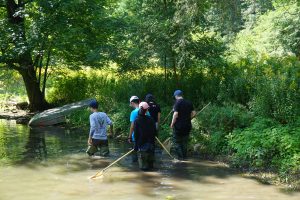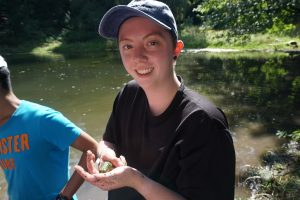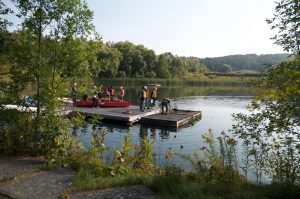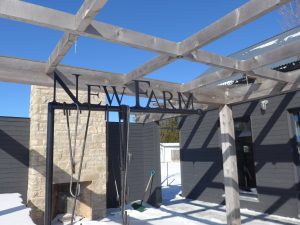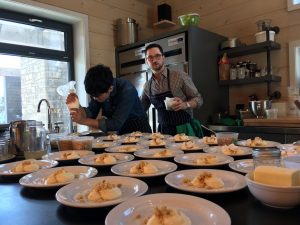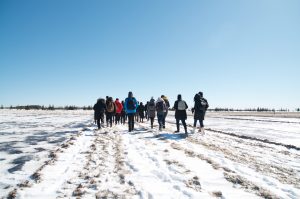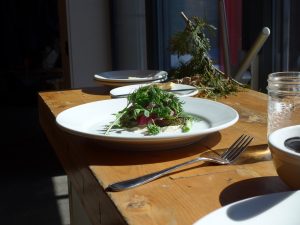Hear from Environment and Sustainability Students
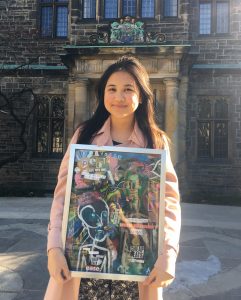
We asked Angel about her experience in the program after her TCURC presentation which she displayed her original artwork from her TrinOne class.
Why did you pick the Trinity One Environment & Sustainability Stream?
I picked the environment stream because I have been working at the Humber arboretum since I was 13. From there I was thrust into nature, because it has 250 acres of forest space. I have always been interested in the environment as a result of that. I have been interested specifically in dendrochronology – the study of tree rings. I figured if I wanted to do Trinity One because it was a smaller class, then the Environment and Sustainability stream pertained to most of my interests.
What was your favorite experience at the arboretum?
I was a camp counselor and my favorite thing was seeing how kids interact with nature differently than adults. Adults become desentized to nature especially because now we live in a world that’s all technology and it’s easier to become entranced by iPads and screens but kids really liked to get their hands dirty and I liked being in that kind of environment.
What do you like about being in the Trinity One Environment & Sustainability stream?
I really like the field trips! Because it’s an environment focused course I like that it takes that into account. I feel like a lot of the environment courses focus on the science and textbooks and things like that and it’s so easy to forget that part of learning the environment is being in the environment, so I have been enjoying that part of it. Sometimes we just hang out in the quad!
The artwork you submitted for TCURC titled “Today’s Specials”, what inspired you to make it?
For my TrinOne class, we had to take a research article and translate it so it can be digestible for the average audience because there are lots of research jargon in articles. I decided to do a painting. It’s a critique of the racialized structuralization of diet. The article I was looking at was studying which race’s diet consumed the most greenhouse gases – land and water. I thought that that was a huge sweeping generalization because you don’t make dietary choices because of your race. I found that it was because of the disproportionate food security across different racial groups. I wanted to put that into a painting – so I made 2 figures representative of people of color in America and white people in America – and how corporations haven’t been finding importance in their responsibility in terms of food security because they have a huge role to play in what people are consuming.
What are your plans going forward and how has Trinity One impacted you?
I’m hoping to major in Chemistry and English and minor in Environmental Studies. I was not planning on doing an Environmental Studies minor – I was planning on doing Environmental Chemistry – but it has definitely impacted me in the sense that I’m more cognizant of my environmental impact especially in school and I hope to be able to carry that forward into the future. I want to be able to work on plastic pollution. I didn’t realize how big the plastic pollution problem was in developing countries until I got to the Trinity One Environment & Sustainability class and I was prompted to by an assignment! Going forward into the future, I want to work with kids and help them to live in a world that doesn’t have plastic mountains growing out of the oceans!
Hands on Learning: Sustainability Stream’s Visit to Koffler Scientific Reserve
How should we define “sustainable”? What does sustainability mean in the 21st century? How can ethics and environmental science collaborate to encourage not just sustainable but also regenerative practices? These are the types of questions we ask in TRN140 and TRN141, the two courses in the Butterfield Environment and Sustainability stream of Trinity One. One of my favourite things about the Environmental stream was the hands-on learning, such as the trip to University of Toronto’s Koffler Scientific Reserve, a centre for conservation, research, and outreach.
The United Nations Brundtland Commission defines sustainability as “meeting the needs of the present without compromising the ability of future generations to meet their own needs.” We subconsciously explored KSR with this definition at the back of our minds, as we learned the importance of leaving no trace in our time as to give future generations a chance to thrive better than we have. At KSR, many species of turtles resided in their pools, some of which are half decades old and still growing. This, along with some of the other long-living trees and vegetation that we encountered, put into perspective the importance of conservation and habitat protection for animals who are dependent on certain conditions. We got to weigh, examine and measure a snapping turtle, who was feisty and snappy!
The trip to KSR, and our course content in general, placed a focus on regeneration. Regenerative sustainability can take many forms, whether that may be ecological or social regeneration, such as recovering bee populations or offering nutritious community kitchens and cooking classes for the disadvantaged rather than food banks. Regenerative architecture was present all around us at KSR, as buildings were constructed to be insulated for cold winters and cool for hot summers, with many buildings producing a net- positive or net-zero effect on the environment.
Our trip to KSR was eye-opening in more ways than one, as we rafted on the shallow ponds, trekked in the mud to find frogs and turtles, and went up close and personal with various wildlife that had its last bloom in the mid September air. KSR is a place that inspires research, and allows students and grads to do science instead of studying it from a manual, which drives the view that we are all part of one ecosystem, and we should work within it to truly understand it.
Trinity One Students Experience Sustainable Practices at the New Farm
Farming is rarely a topic that is associated with sustainability, due to the highly publicized negative effects of agriculture on the environment and soil quality. Two Toronto professionals, sought to change our understanding of agriculture more than ten years ago, by leaving their desk jobs to pursue organic farming. Brent Preston and Gillian Flies built the New Farm from the ground up, a 100 acre certified organic plot just west of Creemore, Ontario.
On a recent field trip to the New Farm, I experienced a first hand account of how the small farm is able to give back to the community and nourish the environment, all while turning a profit. We were given a tour around the farm’s crops, and learned about the farm’s “no till” rule, and their organic practices that align with the Canadian Organic Standard. Every spring and summer, the farm flourishes with hand-planted salad greens, vegetables, and herbs that are grown in the nearby herb garden. Brent and Gillian shared their story with us, and their journey to take the farm to where it is today. After much trial and error, as well as learning from other organic farmers, they slowly found the right consumers for their organic produce: locals, organic retail, restaurants in the GTA, and organizations like Community Food Centres Canada.
Brent and Gillian organized a private farm-to-table lunch for our group, with fresh ingredients and chefs from Richmond Station, a seasonal restaurant that sources from New Farm. We then got a comprehensive tour of The Kitchen, the education and dining space of the farm. All of the farm buildings have been engineered to be energy efficient and through the use of thick insulated walls, keep the interior warm during the winter and cool during the summer. The consciousness around energy use, giving back, and further education is what stood out about the New Farm.
Our visit to the New Farm was eye-opening, and equally thought provoking. Farming and agriculture seem like an impossible dream to the average city dweller with no agriculture or horticulture experience, but Brent and Gillian proved that it can be accomplished. Striving towards a sustainable and ethical farming future is possible even at home, by supporting local farmers and purchasing free range and organic food.
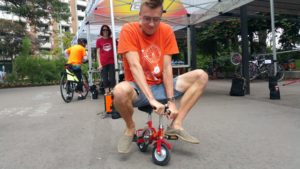
Nathan Postma shares his thought about our new Butterfield Environment & Sustainability stream and universities’ role concerning climate change and sustainability. Nathan is a 4th year Trinity College student studying Environmental Studies and Anthropology.
What do you think of the new Butterfield Environment & Sustainability stream? How would this stream have affected your first-year studies?
Ah so many thoughts! Firstly, one of the most exciting aspects of the Butterfield’s generous contribution is their commitment to sustainable investment. I am very excited to see that the program will be financially sustained via the returns from ecologically conscious portfolios. Thank you Greenchip Financial! Trinity is well positioned to perpetuate a trend that seeks, through the realignment of subsidies and investments, to push green innovation and drop prices for sustainable products (see the decline in solar energy prices over the last decade as an example of this trend in action). After all, genuinely pursuing a sustainable future means heavily polluting behaviours should be the expensive choice, not the other way around! Further, the funding structure aligns with divestment initiatives already present at this college –namely the inspiring work of Trinity College Humphreys Chaplain Andrea Budgey who, along with Anglican Minister Maggie Helwig and activist Taylor Flook, took direct action against TD Bank to express solidarity with the Standing Rock Sioux Tribe.
Switching to the benefits of the educational content itself, I love how the Butterfield Environment & Sustainability stream will not shy away from teaching the complex, interwoven nature of environmental and social justice issues. For example, recognizing how increasing numbers of climate refugees –that is those forced to flee homes due to warming trends and rising seas – influences domestic politics in the US (the world’s second largest carbon emitter), which in turn informs their recent undermining of international environmental protocols. Environmentalism, politics, humanitarian crises and climate are all wrapped up in one! Typically this understanding emerges slowly through course content over second and third year environmental studies; fore fronting this connection early is an enormous benefit for first year students. Had I gained this lens in my first year studies, I would have been better positions to dive deeper into environmental and social justice course content. In my experience, thinking beyond the course is the best route to both personal intellectual growth and productive connections with professors (they are always more receptive to critically engaged students)!
Ultimately, the new stream inspires optimism in me. I am confident that the new Trinity One stream will guide its cohorts in challenging their assumptions about environmental problems and about the natural world in general. Just framing the environmental crisis is a big part of the battle! Much of the environmental crisis can be linked to a disconnect between people’s material demands, as informed by the assumptions of the political and economic structures that surround them, and the real limits of the planet itself. The Butterfield Environment & Sustainability stream will get students exploring the subtle sources of this disconnect early. In my mind, I see this opening the window for more innovative thinking to happen around sustainability issues.
As a fourth year student in Environmental Studies, what are some of the projects you are working on now?
In my role at Co-President of the Trinity College Environmental Society (TCES), I am helping a legacy of waste free events (as left by now graduated presidents) continue through our reusable stein program. Organizing DIY workshops and trips to places like the Evergreen Brickworks are other ways the TCES makes sustainability issues engaging and fun. Huge compliments to the capable, passionate executive that engage with this club!
Additionally, I was fortunate to be hired as a Research Assistant with Professor John Robinson, Presidential Advisor on Environment, Climate Change and Sustainability. This project seeks to innovate how sustainability courses are organized and communicated at the University of Toronto. Accomplishing this goal means identifying all of the sustainability courses already being taught (over 1500 courses representing 20% of all U of T courses!) and crafting “Sustainability Pathways” — that is a curricular structure which would show a student studying anything from English to Human Biology 1) the sustainability courses already present in their departments and 2) how they could be taken while still fulfilling degree requirements. Our team sees sustainability as a fundamentally interdisciplinary pursuit, so we are trying to change the education structure to reflect this.
Lastly (full disclosure this is the project I am most excited about!) I am working with a dedicated team, including fellow TCES members Emily Shaw and Emily Neeson, to turn a semester of research conducted in Professor Robinson’s “The U of T Campus as a Living Lab of Sustainability” course into a food producing green roof atop the Munk School of Global Affairs building. This project originated from Trinity’s Assistant Provost, Dr. Jonathan Steels, as a means to source local produce for food services as well as create a space to deliver environmental programming to students. We also intend to conduct research on the viability of roof gardens to retain rainfall after heavy storms –an important climate change adaptation strategy for cities with aging water treatment infrastructure. There is a stereotype that only engineers and computer science majors conduct this kind of practical fourth year project, but it is crucial that environmental studies majors pursue these as well! U of T has an enormous amount of support already waiting for students with initiative.
What role do you think universities have when it comes to climate change and sustainability?
Over the course of my undergrad I’ve been able to reflect on the state of postsecondary education with a variety of faculty members. Since the 2008 financial crisis, the Provincial and Federal Governments have been realigning their funding priorities to ensure that students leave University with “career ready” skills gained through experiential learning courses. I believe this is beneficial in the context of climate change and sustainability. University graduates should leave their education with both applied and research skills. To this end, engaging with the “Campus as a Living Lab” model is a promising way to deliver the aforementioned skills to students. The “Living Lab” model recognizes that Universities operate at an ideal scale – that is the community scale (smaller than a city, but larger than a neighbourhood) – and are relatively autonomous in their governance; thus, there is enormous potential to test out approaches to sustainability issues at the campus level. Here, it is ok if projects fail initially; there is another cohort of students right behind ready to learn from the mistakes and try again.
Once a group gets an impactful and innovative approach down, a knowledge transfer can take place between the University and the global community connected to it. I believe Universities should also expand their role in creating robust networks between student sustainability advocates, frontline community members and pioneering actors in the private sector. Already students build lifelong connections between their peers during their studies and extracurricular involvement, but more needs to be done to achieve the level of change required to face the environmental crisis. Fortunately, the path to this sustainable future is not obscure: countless successful social movements have demonstrated that active community networks are a primary axis of progressive social change. Fostering existing relationships with committed administrative support and building new networks through targeted outreach campaigns can, when coupled with engaging experiential learning courses, position Universities as “Agents of Change” in the context of sustainability and climate change issues.
